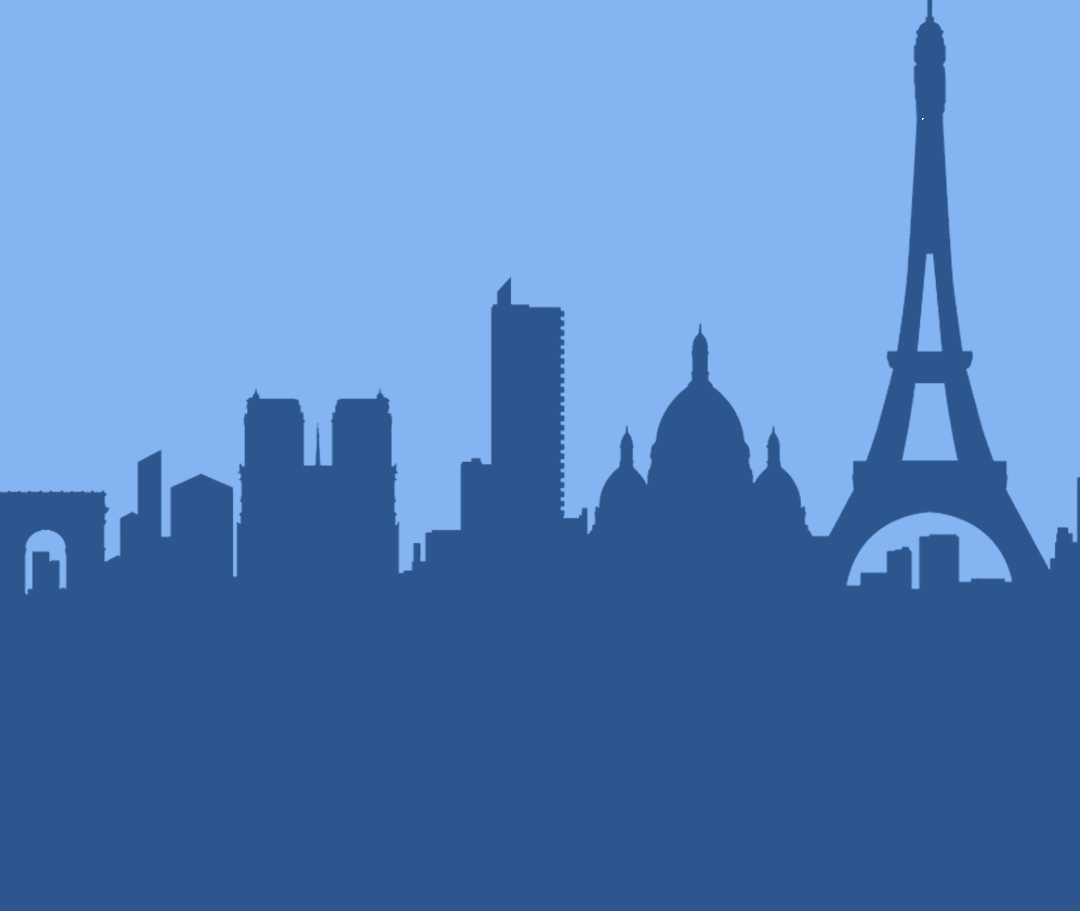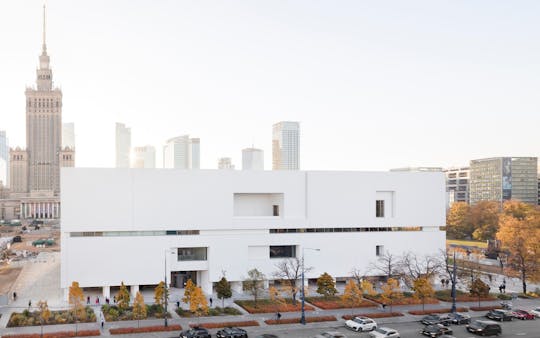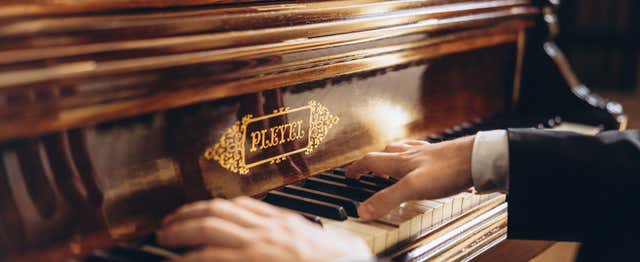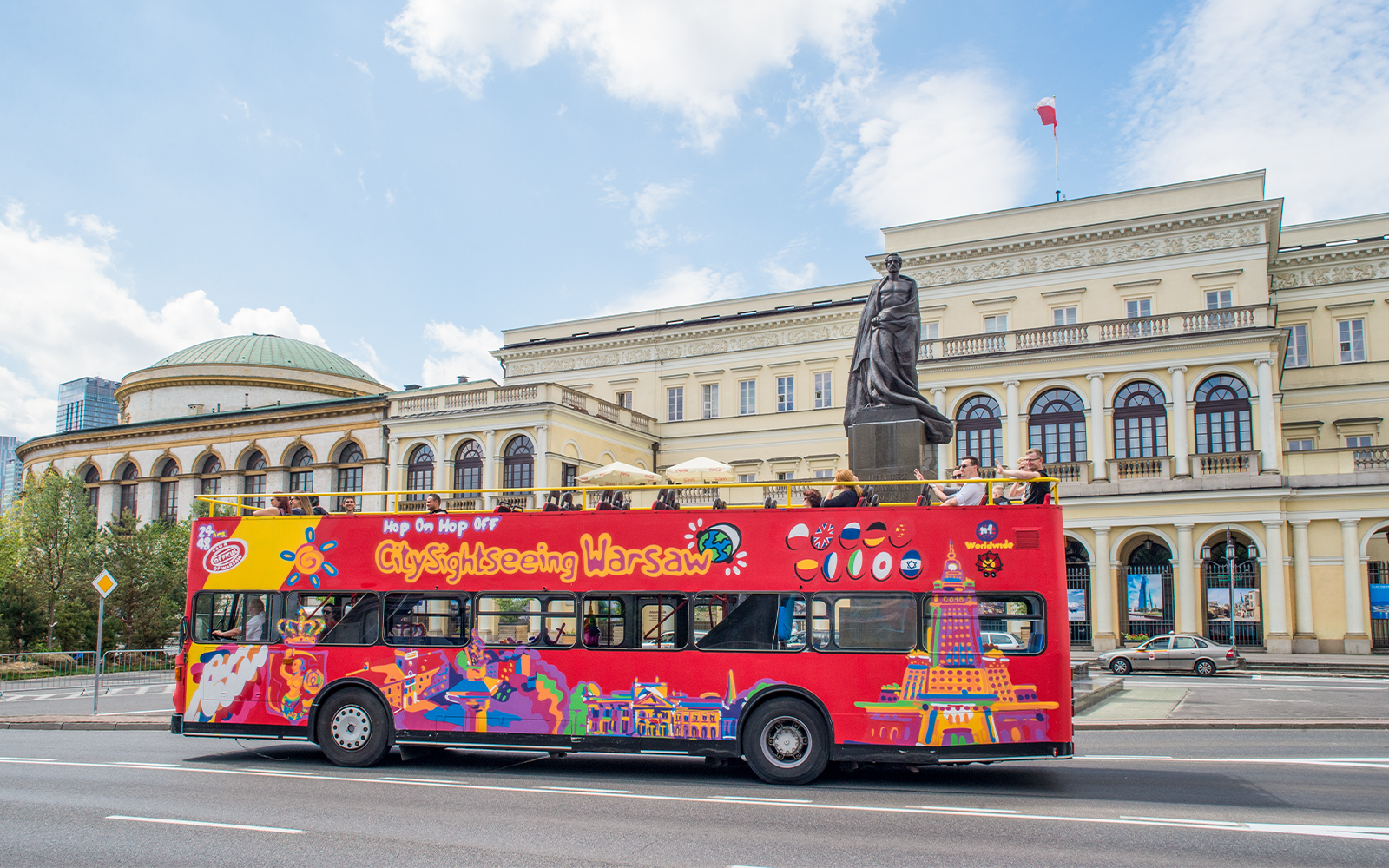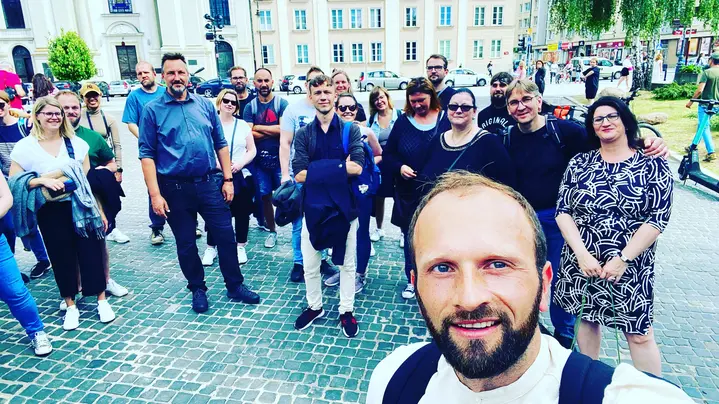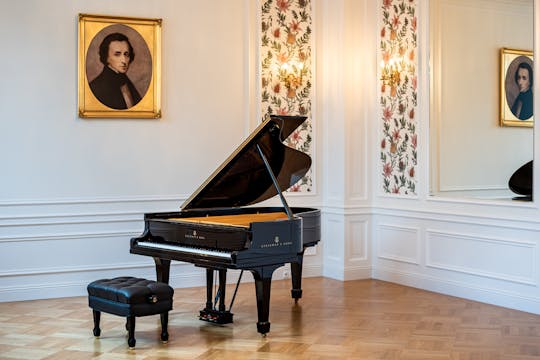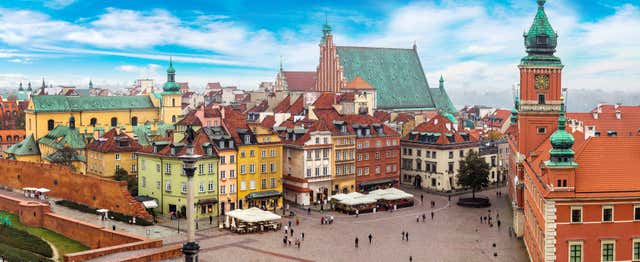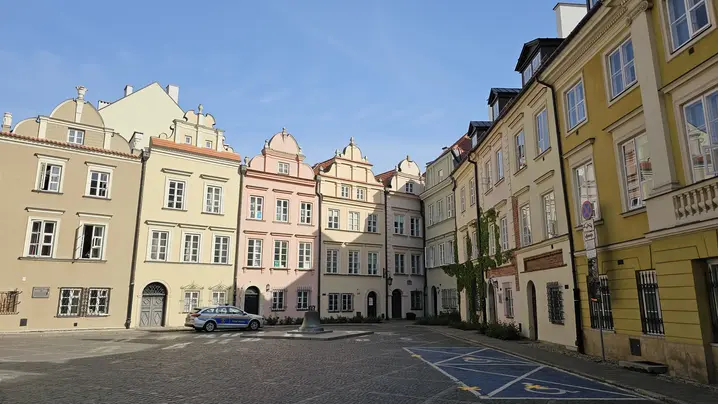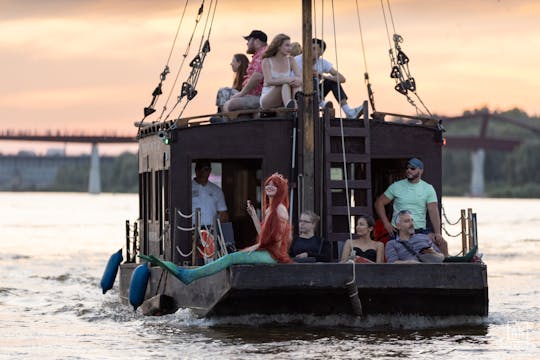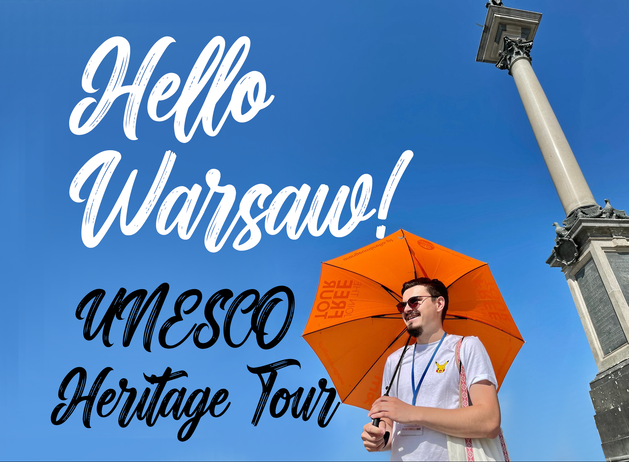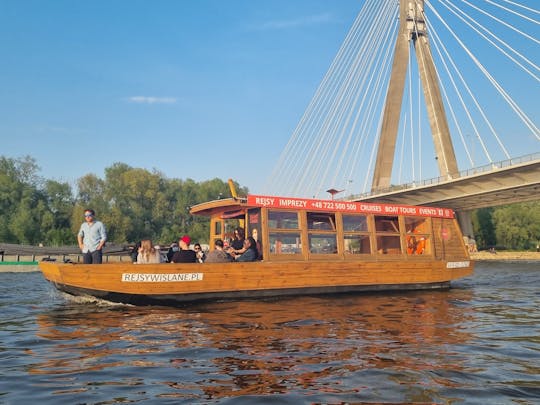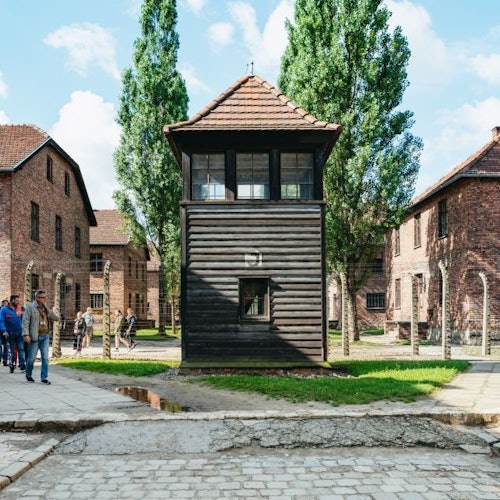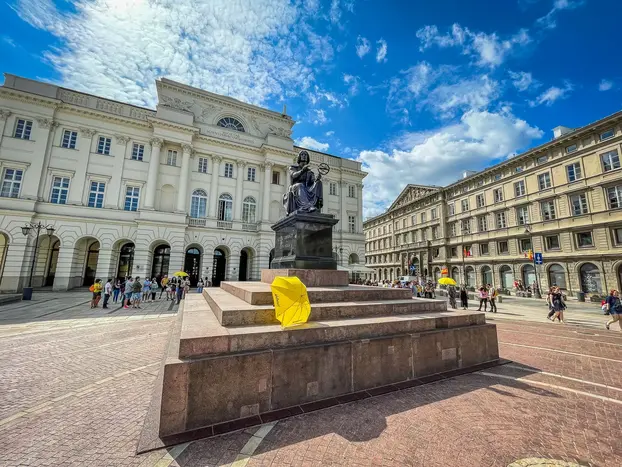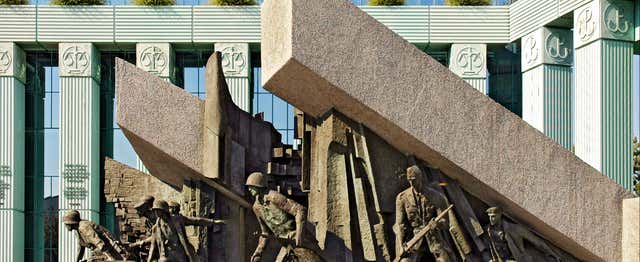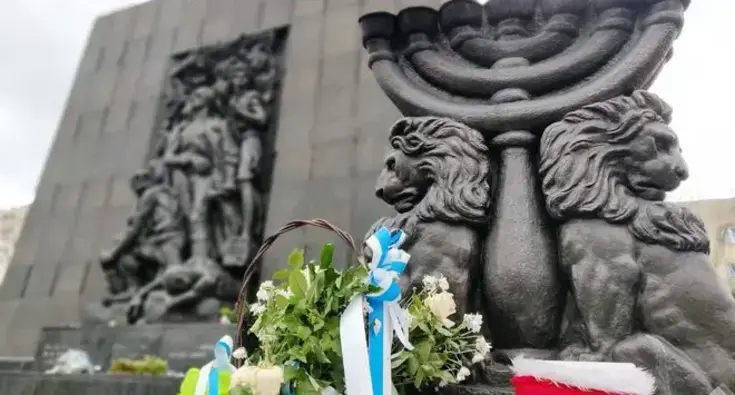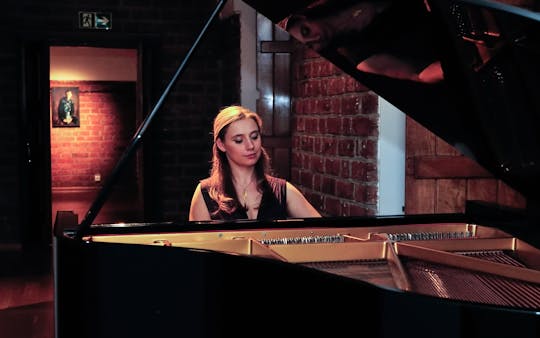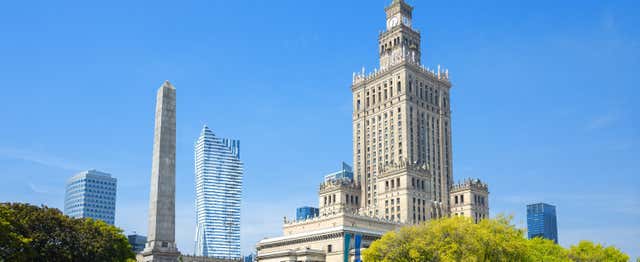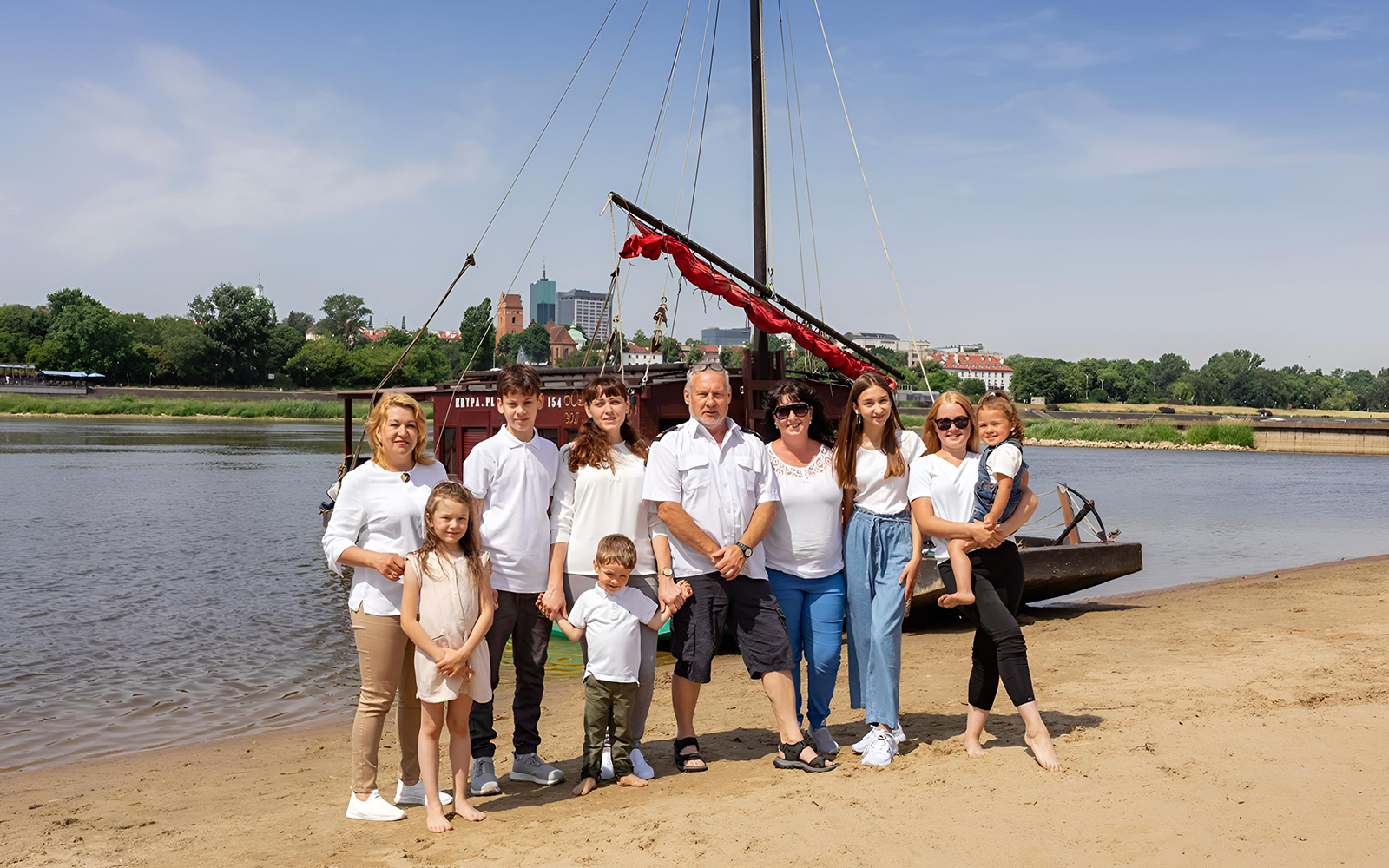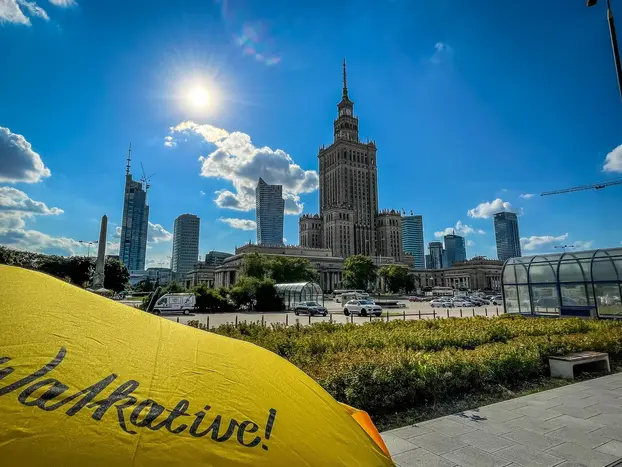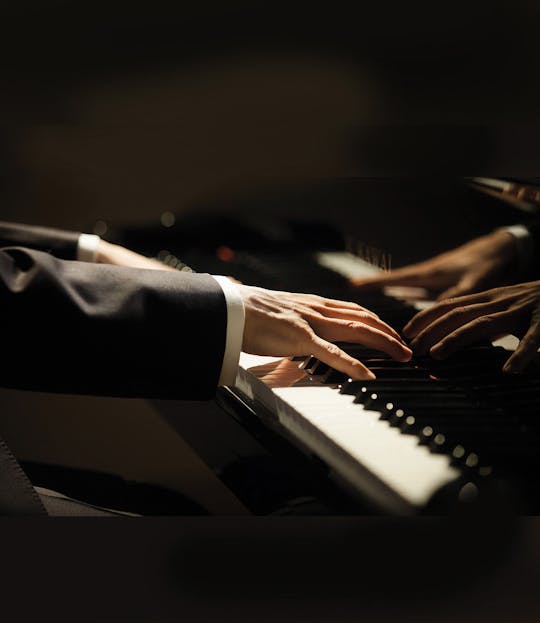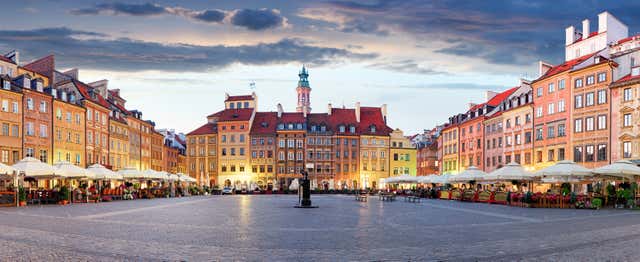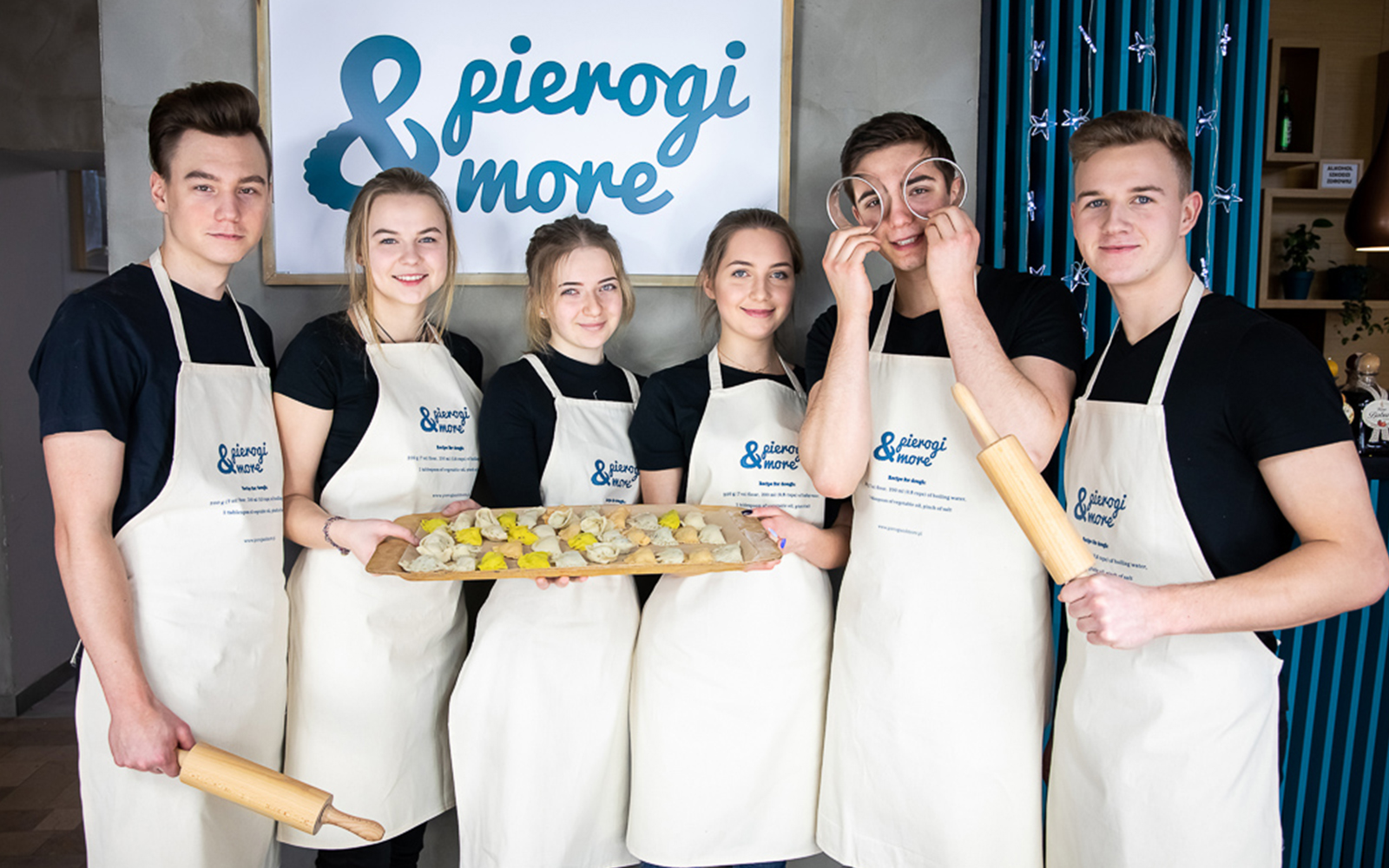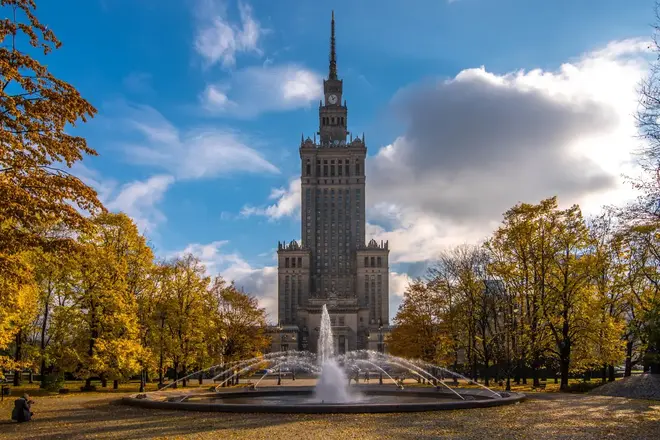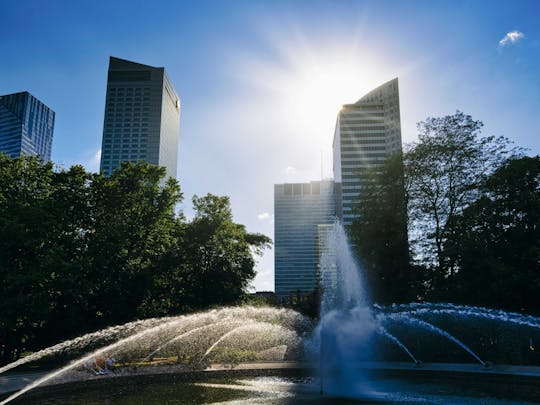Things to Do in Warsaw
• Ride Red/Blue routes to 26 key sights with audio guides in 10 languages, kids' commentary in Polish, open-top buses for perfect photo ops, plus free child tickets (age 0-5).
• Step off to explore POLIN Museum's moving Jewish history, Wilanów Palace's grandeur, Zachęta's masterpieces, and Old Town's timeless charm.
We are Antek and Tomek and we would like to invite you on our very personal city tour through the Old Town.
We live on the right side of Warsaw, in the Praga district, and we are out and about on the left side every day. We would be thrilled if you would join us.
In addition to the classic sights, we also want to show you the many small, hidden gems:
- Castle Square with the Sigismund's Column
- The beautiful Royal Castle as seen from the Royal Gardens
- The viewing platform in the Old Town, where I will explain the uniqueness of the Vistula Valley in Warsaw
- The Market Square with the colorful reconstructed houses
- The city walls with the Barbican
- The birthplace of Marie Curie
- The Ghetto Wall Monument
- The Warsaw Uprising Monument
We have added "More" to the name of the tour so that you know it is more than just a simple walk through the Old Town.
Of course, we will talk about Polish cuisine and vodka. We will also give you many tips on where you can eat in peace and where to find the best traditional cakes.
We are both Warsaw natives who love this city like our own family. During our tours, we welcome every unexpected question. And once we have started a conversation, you too will come to love this city.
• Save money as you indulge in delicious Polish cuisine on food tours, explore the city on guided tours, or stay at premium hotels with special discounts.
• See artworks like *Madonna and Child* by Botticelli at the National Museum and journey through space at the Copernicus Science Centre.
• Sample drinks at the Polish Vodka Museum and ascend to a viewing deck 114m above ground at the Palace of Culture and Science.
• Did you know? Warsaw is often referred to as the ‘Phoenix City’ because it was rebuilt from the ashes after World War II.
Warsaw for Beginners – Free Walking Tour (2:30 Hours, 3.8 km)
Perfect for first-time visitors, this tour takes you through Warsaw’s must-see landmarks, blending history, culture, and local insights. In just 2:30 hours, you’ll get an essential introduction to Poland’s capital.
Meeting Point: Palace of Culture and Science
Start: In front of the entrance of Kinoteka (cinema)
Tour Itinerary:
🔹 1. Palace of Culture and Science (PKiN)
- Warsaw’s most controversial building, a "gift" from Stalin in the 1950s
- Why locals have a love-hate relationship with it
🔹 2. Nowy Świat and Krakowskie Przedmieście
- One of Warsaw’s most beautiful streets, part of the Royal Route
- Presidential Palace – seat of Poland’s President, but with a dramatic history
- Holy Cross Church – where Chopin’s heart is kept
🔹 3. Castle Square & The Royal Castle
- Why the Royal Castle is not as old as it looks
- The story of Sigismund’s Column – and how it survived WWII
- Warsaw’s complete post-war reconstruction
🔹 4. Old Town Market Square
- A fairytale square rebuilt from ruins
- The legend of the Warsaw Mermaid – the city’s protector
🔹 5. Warsaw Barbican & City Walls
- Medieval fortifications that once protected the city
Get a taste of local culture, discover quirky facts, and unveil hidden treasures. What's more? You'll have the chance to ask all your burning questions along the way. This isn't just a tour - it's your backstage pass to the heart of the city!
The tour takes place with a minimum of 2 walkers.
NO CARD PAYMENT:(
• Ready for a glimpse of the endangered Rothschild giraffes? It's not every day you get to see these elegant creatures.
• Your ticket is your gateway to explore diverse habitats – from African elephants to native Polish storks.
• Not just land animals, the ticket includes access to a vibrant underwater world! Check out the shark aquarium and meet the clownfish family.
• Did you know? During WWII, this zoo was a secret refuge for people as depicted in the film *The Zookeeper's Wife*.
All you need to know about Warsaw in one tour.
This 2-hour tour, guided by Warsaw enthusiasts, is your perfect Warsaw starter pack, including must-see spots of the 2 oldest Warsaw districts, its lesser-known gems, and stories and legends that bring them to life.
On this 2-hour long tour, we will show you the essentials. You will explore the medieval core of Warsaw: founded in the early 14th century the Old Town, and established one hundred years later - the so-called New Town (the second oldest district of Warsaw). You will learn how Warsaw, from a wooden medieval settlement, in 700 years marked by invasions and occupations, developed into a big, modern, European capital.
You will see and understand stories behind:
- The Royal Castle
- Sigismund’s Column
- The Cathedral of Saint John
- The Magic Bell
- The Vistula River viewpoint
- Market Square
- Medieval defensive walls
- The Barbican
- Marie Curie’s birthplace
- The monument of the Warsaw Uprising
Expect tons of history seasoned with anecdotes, legends and insider tips.
At the end of the tour you will get a printed MINI GUIDE about major Warsaw tourist attractions, most-visited museums, local food delicacies and city hacks.
Discover the most bohemian and alternative part of Warsaw on this free tour through the Praga district. The perfect opportunity to get to know Polish culture!
• Marvel at the grandeur of Poland’s 2nd tallest building. Immerse yourself in its architectural and historical significance through a PDF guidebook.
• Get panoramic views of the capital from a height of 114 m. Click stunning photos from a vantage point like no other!
• Upgrade to include a 1-hr English-guided tour of the palace and gain valuable insights into Polish culture, history, and science.
• Fun Fact: The Palace has hosted many famous artists over the years, including Elvis Presley, Sting, and The Rolling Stones!
A city that suffered tremendous losses over the last 100 years. Come and see how it rose like a phoenix from the ashes: experience the invincible spirit of Warsaw and learn about the heroism of its people.
Today’s Warsaw is a like a patchwork quilt. A few original, grand pre-war buildings; the fully reconstructed and colourful Old Town, a UNESCO World Heritage Site; hulking communist architecture and modern skyscrapers. It is different than any other place you’ve seen. The architectural fabric of the city reflects its unique, and often tumultuous, history. Over the centuries, Warsaw has been the setting for many extraordinary events and people: the adoption of the world’s second-oldest democratic constitution in 1791, one of the most decisive battles in history, the music and life of Chopin, and the birth of Marie Skłodowska-Curie, the only person to receive the Nobel Prize in two different scientific fields. The wartime deeds of Hitler and Stalin left an indelible mark on the city.
During our tour we’ll discover both the past and the present. We’ll start at Krakowskie Przedmieście at the monument of Nicolaus Copernicus to see one of the most beautiful and lively streets of the city with its astonishing buildings, wide pedestrian areas, restaurants, shops, and greenery, and we’ll finish in the Old Town – the historical heart of Warsaw.
But Warsaw is not only about the past. The thriving cultural scene, theater, music, fascinating museums, world-class restaurants and shops make visit to this city a stimulating experience.
Come and join our tour to understand Warsaw, Poles and Poland’s role in world history.
On this 2h 30 minutes’ FREE Walkative! TOUR you will see:
- Copernicus Monument on Krakowskie Przedmieście Street
- Royal Castle
- University of Warsaw
- The presidential palace
- Sigmund Column
- Old town Market Square
- St. John Cathedral
- and much more…!
The last stop is near the Zygmunt’s Column.
ℹ️ ⚠️ ATTENTION - booking rules
Please note that our free tours are designed for individual travelers and small private groups only. Hence, we do not accept parties of 8 or more people on regular free tours and guides have the right to deny participation to such groups. If you travel in a party of 8 or more please book a private tour in advance.
If you show up at the meeting point with the bigger group our guide will ask you for the payment (18 eur/person) before the tour or cancel your reservation on the spot. To confirm your reservation please arrive 10 minutes before starting. We can not guarantee participation when you will be late.
Please note that multiply bookings (under different names) for 7 people who belong to one group will still be treated as one organized group and the guide has the right to deny participation to such parties.
This policy is implied in the best interest of our individual visitors.
Please respect our rules.
• Savor a complimentary glass of traditional Polish mead or refreshing apple juice.
• Attend a live piano concert in the elegant Pleyel Salon, located in the heart of Warsaw’s historic Old Town.
• Opt for premium seats in the first 2 rows for the best view, or choose standard seating in rows three to five.
• Did you know? Frederic Chopin often played in the dark and preferred performing for small, intimate audiences.
Before the Second World War, Warsaw was a city with the biggest Jewish community in Europe. The only other city with a Jewish community of similar size was… New York! The story of Jewish Warsaw is a story of stubborn returns. For many years, even centuries, Jews were banned from the city. However, that did not stop them from participating in city life – during good times and bad. Jews joined Varsovians in their struggles against occupying powers, and they played an active part in the Polish uprisings. The city experienced a major influx of Jews in the 19th and 20th centuries. During the Interwar Period, Jewish Warsaw flourished. Hundreds of artists, actors, writers, and journalists called the city home. Its cultural life was incomparable to any other time and place in history. Realizing what Warsaw was helps us understand the tremendous loss.
The Second World War and Holocaust left the city changed forever. The wounds and scars will never heal. But, alongside stories of destruction, there are stories of the unimaginable bravery of those who fought without hope. There are also stories of the present; stories of rebirth… Let’s get back first to the past. This city was once famous for its Jewish culture. There are many people whose names history will never forget and Varsovians will always be proud of: Ludwig Zamenhoff, the inventor of Esperanto; Isaac Bashevis Singer (born Icchok Baszewis Singer), who won the Nobel Prize for literature are just two examples.
The stories of the Warsaw Ghetto and the Uprising there, and of people like Janusz Korczak and Mordechai Anielewicz will leave you trembling. While the story of Oskar Schindler’s rescue of over a thousand Kraków Jews has become internationally famous with the release of the film Schindler’s List, a much less well-known story is that of Warsaw resident Irena Sendler, who actually saved more Jews than Schindler did. Her story is depicted in The Courageous Heart of Irena Sendler. Last, but not least, it is worth mentioning one more person made famous by a Hollywood film: Władysław Szpilman, better known as The Pianist from Roman Polański’s film. But there is more to Jewish Warsaw than the past. There is also the here and now – the living Jewish community with a synagogue, kindergarten, school, and the only regularly functioning Yiddish theatre in the world: the Ester Rachela Kamińska Jewish Theatre.
To discover all of this, just come and join us at the meeting point and be ready for journey through times and emotions!
ℹ️ ⚠️ ATTENTION - booking rules
Please note that our free tours are designed for individual travelers and small private groups only. Hence, we do not accept parties of 8 or more people on regular free tours and guides have the right to deny participation to such groups. If you travel in a party of 8 or more please book a private tour in advance.
If you show up at the meeting point with the bigger group our guide will ask you for the payment (18 eur/person) before the tour or cancel your reservation on the spot. To confirm your reservation please arrive 10 minutes before starting. We can not guarantee participation when you will be late.
Please note that multiply bookings (under different names) for 7 people who belong to one group will still be treated as one organized group and the guide has the right to deny participation to such parties.
This policy is implied in the best interest of our individual visitors.
Please respect our rules.
• Enjoy an intimate boating experience on a 12-seater Galar ship, armed with a snug blanket.
• Get a unique perspective of Warsaw's architectural marvels like the Copernicus Science Center, the National Stadium, and the Warsaw Mermaid.
• Did you know? The Vistula River often personified as a lady, plays an integral part in Warsaw's folklore, adding an intriguing layer of local storytelling to your cruise.
The thing you simply cannot help not to notice when arriving in Warsaw is the Palace of Culture and Science. Despite the new development and skyscrapers built in the last two decades, the 46-floor Gotham-like colossus still remains the city’s icon. Let us tell you the story behind it: the story of Warsaw between 1945 and 1989. Rebuilt from a sea of ruins and transformed into the grey capital of the communist paradise: the People’s Republic of Poland.
Communism left its marks all over the city; it was meant to overshadow everything that was before and that was to come in the future. Let us show you some of the iconic post-war architectural landmarks and learn about their role in shaping a new kind of person – Homo-Sovieticus. Hear a story of control, terror, and propaganda, but also of the absurdities of daily life under communism. Understand the everyday struggle to have a normal life in a situation that, from today’s point of view, was very abnormal.
We will talk about:
· Everyday life in the People’s Republic of Poland
· The inner workings of communist propaganda
· Examples of monumental architecture
· Anti-communist movement
ℹ️ ⚠️ ATTENTION - booking rules
Please note that our free tours are designed for individual travelers and small private groups only. Hence, we do not accept parties of 8 or more people on regular free tours and guides have the right to deny participation to such groups. If you travel in a party of 8 or more please book a private tour in advance.
If you show up at the meeting point with the bigger group our guide will ask you for the payment (18 eur/person) before the tour or cancel your reservation on the spot. To confirm your reservation please arrive 10 minutes before starting. We can not guarantee participation when you will be late.
Please note that multiply bookings (under different names) for 7 people who belong to one group will still be treated as one organized group and the guide has the right to deny participation to such parties.
This policy is implied in the best interest of our individual visitors.
Please respect our rules.
• Discover various tips and techniques to make the tastiest dumplings from an experienced chef and relish your delicious creations in pierogi dishes.
• Receive detailed recipes, personalized certificates, and photos of your culinary journey via mail.
• Learn to craft and savor festive 4-course dumplings by upgrading to a Polish Christmas experience with traditional liqueur tasting.
• Did you know? Pierogi has been a part of Polish cuisine since the 13th century and is considered to be one of Poland's national dishes.
Cold War Warsaw: Spies, Communism & Hidden Resistance Tour
Step into a world of secrets, shadows, and silent resistance. This immersive journey through Warsaw takes you deep into the heart of Cold War Europe—where spies whispered, ideologies clashed, and freedom fought to rise.
Start at the monumental Hotel MDM, built to impress and control, a showcase of socialist realism. Discover the House of Writers, where writers secretly nurtured rebellion under the radar and smuggled books into Poland from the west.
Then fast-forward to 1992: the first McDonald’s in Poland drew over 13,000 customers on opening day—a dramatic symbol of the Iron Curtain’s collapse and discuss Ryszard Kukliński the most important spy in Polish history.
Marvel at the Palace of Culture and Science, a Stalinist “gift” towering over Warsaw—loved, hated, unforgettable and potentially used by the Polish secret service. Head to the Communist Party HQ, where power once plotted, now eerily silent.
Finish at St. Alexander’s Church and hear how John Paul II, a Polish Pope with a powerful voice, sparked a peaceful revolution, and Ronald Regan, the President of the United states, made a deal to work together. This tour blends espionage, architecture, resistance, and transformation—perfect for lovers of history, politics, and hidden stories.
